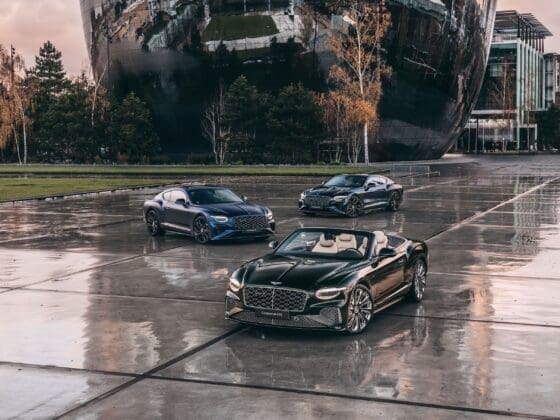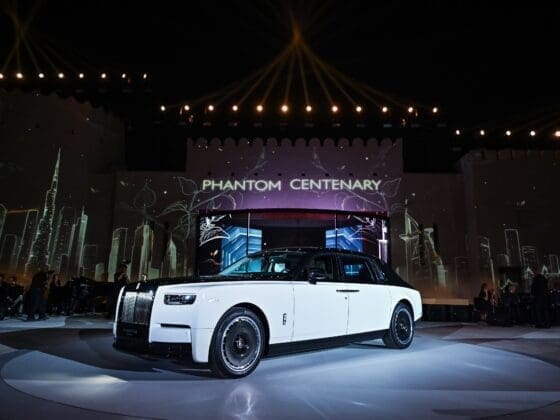Artura is McLaren’s first series-production High-Performance Hybrid supercar. Built on the new McLaren Carbon Lightweight Architecture (MCLA), Artura’s hybrid powertrain combines the marque’s first V6 petrol engine with an E-motor and battery pack capable of running in pure EV mode for up to 30 kilometres. The car also debuts a whole slew of innovations that look set to future in future models.
Following Artura’s debut, Mike Flewitt, CEO of McLaren Automotive, said: “Every drop of McLaren’s experience and expertise has been poured into the Artura. Our all-new, High-Performance Hybrid delivers all of the performance, driver engagement and dynamic excellence for which McLaren is renowned, with the additional benefit of EV driving capability. The introduction of the Artura is a landmark moment – for McLaren, for our customers who will appreciate and enjoy this car on every emotional and rational level, and for the supercar world.”
McLaren’s all-new M630 petrol engine – a 2,993cc twin-turbocharged V6 – is at the heart of Artura’s performance. It delivers a reported power output of 585PS – that’s nearly 200PS per litre – and 585Nm of torque. The dry-sump aluminium engine is compact and lightweight. At just 160kg, it weighs 50kg less than a McLaren V8 and is significantly shorter.

The M630 engine has a 120° V-angle to allow the two turbochargers to be positioned within the ‘hot vee.’ This means a more compact packaging, lower centre of gravity, and increased engine performance by reducing the pressure losses through the exhaust system. It also allows for a stiffer crankshaft that enables a rev limit of 8,500rpm.
The new V6 is complemented by a compact axial flux E-motor, located within the transmission bell housing. Smaller and more power-dense than a conventional radial flux E-motor, it is capable of generating 95PS and 225Nm. It boasts a power density per kilo that is 33 per cent greater than the system used in the McLaren P1. The instantaneous nature of the motor’s torque delivery – known as ‘torque infill’ – is key to the car’s sharp throttle response.
The combination of the V6 and the E-motor enables the Artura to achieve a reported 0-100kmph acceleration in just 3.0 seconds, with 0-200kmph taking 8.3 seconds, and 0-300kmph in 21.5 seconds. The top speed is limited to 330kmph.

The two propulsion systems are integrated via an engine disconnect clutch, driving an all-new, twin-clutch transmission developed specifically for the Artura. Despite having one more ratio than the existing McLaren transmission to optimise power and torque delivery, the lightweight, short-ratio gear cluster is 40mm shorter in length. It also requires no reverse gear because the E-motor takes care of reversing.
The E-motor is powered by a battery pack comprising five lithium-ion modules, offering a usable energy capacity of 7.4kWh and a reported pure EV range of 30km. The battery pack is mounted on a structural carbon fibre floor. This assembly is then bolted onto the rear base of the monocoque, optimising stiffness, weight distribution and crash protection.
The Artura is designed with full Plug-in Hybrid (PHEV) capability and can be charged to an 80% charge level in just 2.5 hours with a standard EVSE cable. The batteries can also harvest power from the combustion engine during driving, tailored to the driving mode selected.
“From the very beginning of the project, designing and engineering the Artura has been all about challenging ourselves to innovate, pushing and pushing to achieve everything we knew a next-generation, High-Performance Hybrid McLaren supercar had to be. As a result, the Artura is all-new; the carbon fibre monocoque, electrical architecture, body, and interior are new. So too is the V6 engine, the transmission – which also integrates a new type of electric motor for the industry – as well as the rear suspension concept and our first-ever electronic differential,” says Geoff Grose, Chief Engineer of McLaren Artura.

Another component debuting on the Artura is the new McLaren Carbon Lightweight Architecture (MCLA). Designed and manufactured at the McLaren Composites Technology Centre (MCTC) in the Sheffield region, MCLA has an advanced flexible chassis design optimised for high-performance hybrid applications. It includes a bespoke battery compartment and a domain-based ethernet electrical architecture with an electrical heating, ventilation and air-conditioning (HVAC) system.
The ethernet architecture reduces cabling by up to 25%, as well as speeding up data transmission. This also facilitates access to advanced driver-assistance systems (ADAS), including Intelligent Adaptive Cruise Control, Lane-Departure Warning, Auto High-Beam Assist and Road-Sign Recognition, as well as Over-The-Air (OTA) software updates.
A demanding regime was implemented, encompassing every area of the Artura, to keep weight to a minimum – from the chassis platform to the compact powertrain system and the weight of cabling used in the electrical systems. This resulted in the Artura having a dry weight of 1,395kg. The total weight of hybrid components is just 130kg, including an 88kg battery pack and 15.4kg E-motor. The result is a DIN kerb weight of 1,498kg, which is on par with comparable supercars that do not have hybrid powertrains.
The exterior design of the Artura – driven by the McLaren design principle of ‘everything for a reason’ – is sculpted to optimise performance and manage airflow for aerodynamic performance and cooling. However, McLaren’s signature design elements are clearly discernable, such as the low-nose, cab-forward and high-tail stance and the dihedral doors – which open closer to the body and house mirrors that fold in more tightly. It has minimal body shutlines and panel joints. The entire rear clamshell is engineered and super formed as one panel. The centre of the front splitter doubles as the intake for the eHVAC system, as well as housing the front-mounted radar that forms part of the optional ADAS package.
Inside, the Artura’s cockpit is centred more than ever around the driver. It debuts an all-new Clubsport seat, which combines the range of motion expected of a moveable backrest with the lightweight and support of a bucket seat. The whole seat pivots as one through an elliptical arc when adjusted, combining under-thigh support, seat height and backrest in one movement.
The cockpit’s carbon fibre shell combines with slim facia and doors to allow the driver to stretch out with generous knee- and leg-room, even with the backrest significantly reclined. The steering wheel is kept clear of unnecessary switches. McLaren’s new infotainment and connectivity system MIS II utilises two high-definition screens. The interface is built on an updated software and hardware platform, along with updated versions of McLaren apps and a redesigned navigation map. The instrument cluster’s stealth mode hides non-essential content on the main binnacle.
Designed to excel on both road and track, Artura offers four driving modes – an E-mode for electric-only driving, Comfort mode for mixed driving conditions, and the Sport and Track modes in which the electric power is deployed in an increasingly aggressive manner for low-end response and acceleration.
Artura debuts McLaren’s first-ever deployment of an electronically controlled differential (E-diff), to independently control torque moving across the rear axle. Lighter, more controllable and smaller than a mechanical locking differential, the E-diff locks and unlocks individual rear wheels to improve traction out of corners. This innovative rear suspension system maximises vehicle stability and precision, and reduces understeer out of a corner while accelerating.

The Artura’s P-ZERO tyres feature Pirelli’s “Cyber Tyre” technology – an electronic ‘chip’ inside each tyre that generates real-time data and relays it to the car’s stability control systems to optimise tyre performance. The tyres also feature Pirelli’s patented Noise Cancelling System (PNCS) – a sound-absorbing device on the inside wall to reduce vibration and noise.
McLaren Artura is available to order from McLaren retailers, with first deliveries to customers expected to commence in Q3 this year. In addition to the standard specification, the Artura is offered with three additional core specifications: Performance for a sporting, functional aesthetic; TechLux, as the name suggests, focus on technical luxury; Vision displays a more avant-garde and adventurous look and feel. Every McLaren Artura comes with a five-year vehicle warranty, a six-year battery warranty and a 10-year body warranty.

















